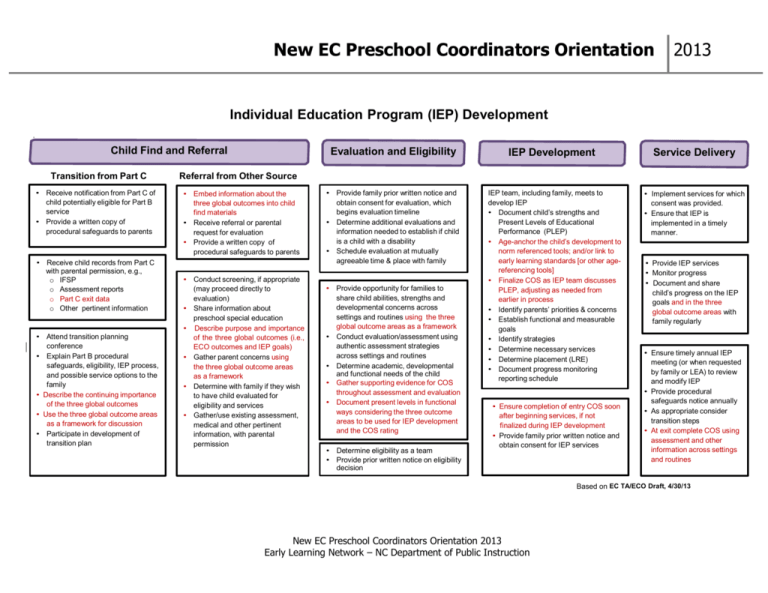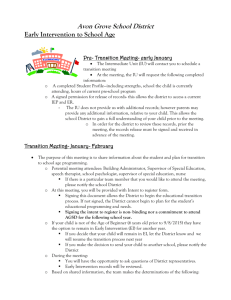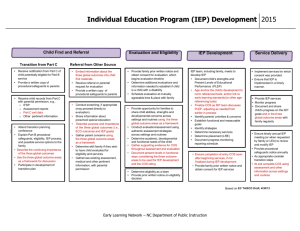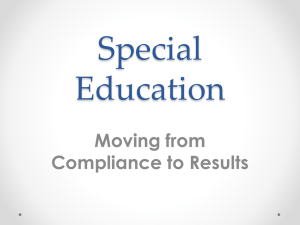IEP Development for EC Preschool Coordinators
advertisement

New EC Preschool Coordinators Orientation 2013 Individual Education Program (IEP) Development . Child Find and Referral Transition from Part C • Receive notification from Part C of child potentially eligible for Part B service • Provide a written copy of procedural safeguards to parents • Receive child records from Part C with parental permission, e.g., o IFSP o Assessment reports o Part C exit data o Other pertinent information • Attend transition planning conference • Explain Part B procedural safeguards, eligibility, IEP process, and possible service options to the family • Describe the continuing importance of the three global outcomes • Use the three global outcome areas as a framework for discussion • Participate in development of transition plan Evaluation and Eligibility IEP Development Service Delivery Referral from Other Source • Embed information about the three global outcomes into child find materials • Receive referral or parental request for evaluation • Provide a written copy of procedural safeguards to parents • Conduct screening, if appropriate (may proceed directly to evaluation) • Share information about preschool special education • Describe purpose and importance of the three global outcomes (i.e., ECO outcomes and IEP goals) • Gather parent concerns using the three global outcome areas as a framework • Determine with family if they wish to have child evaluated for eligibility and services • Gather/use existing assessment, medical and other pertinent information, with parental permission • Provide family prior written notice and obtain consent for evaluation, which begins evaluation timeline • Determine additional evaluations and information needed to establish if child is a child with a disability • Schedule evaluation at mutually agreeable time & place with family • Provide opportunity for families to share child abilities, strengths and developmental concerns across settings and routines using the three global outcome areas as a framework • Conduct evaluation/assessment using authentic assessment strategies across settings and routines • Determine academic, developmental and functional needs of the child • Gather supporting evidence for COS throughout assessment and evaluation • Document present levels in functional ways considering the three outcome areas to be used for IEP development and the COS rating • Determine eligibility as a team • Provide prior written notice on eligibility decision IEP team, including family, meets to develop IEP • Document child’s strengths and Present Levels of Educational Performance (PLEP) • Age-anchor the child’s development to norm referenced tools; and/or link to early learning standards [or other agereferencing tools] • Finalize COS as IEP team discusses PLEP, adjusting as needed from earlier in process • Identify parents’ priorities & concerns • Establish functional and measurable goals • Identify strategies • Determine necessary services • Determine placement (LRE) • Document progress monitoring reporting schedule • Ensure completion of entry COS soon after beginning services, if not finalized during IEP development • Provide family prior written notice and obtain consent for IEP services • Implement services for which consent was provided. • Ensure that IEP is implemented in a timely manner. • Provide IEP services • Monitor progress • Document and share child’s progress on the IEP goals and in the three global outcome areas with family regularly • Ensure timely annual IEP meeting (or when requested by family or LEA) to review and modify IEP • Provide procedural safeguards notice annually • As appropriate consider transition steps • At exit complete COS using assessment and other information across settings and routines Based on EC TA/ECO Draft, 4/30/13 New EC Preschool Coordinators Orientation 2013 Early Learning Network – NC Department of Public Instruction






